|
Click any typewriter
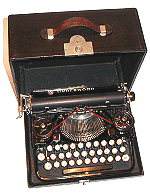
Underwood Portable
1919
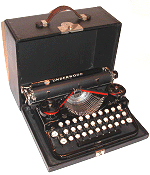
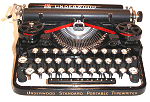
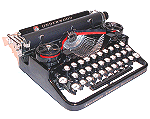
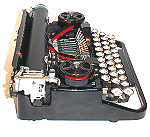
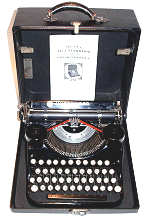
Underwood
4-bank
Portable - 1926
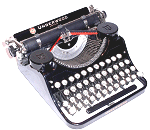
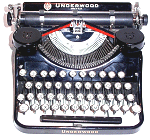
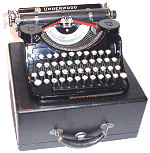



|
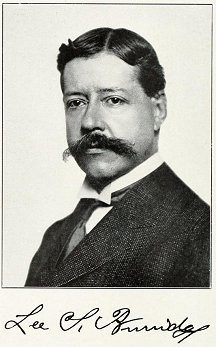 How
the Underwood Portable typewriter of 1919 came into being is a
remarkable story, for much of which I am indebted to Australian
researcher and collector Robert Messenger. Underwood entered the
desk typewriter market in 1900, in competition with Remington. The
company quickly scored great market success because it bought the
patents of the machine designed by Franz Wagner - the first mass
produced front-strike machine. By 1915, Underwood had become the leading manufacturer of desk machines in terms of
numbers sold and its salesmen boasted to prospective customers that the company sold more
typewriters than all other manufacturers combined. But underneath the bold exterior, Underwood
executives were worried. The company had been
casting anxious glances at the potential market that its new upstart
rival, Corona, had created and was exploiting so successfully. The future might well lie with portable typewriters. Underwood
thus set itself to manufacture its own portable machine and become dominant
in portables too. What the company needed now was another
Franz Wagner - this time with a design as original in portables as
Wagner's had been in desk machines. It found its new design
champion in the form of Lee Burridge. How
the Underwood Portable typewriter of 1919 came into being is a
remarkable story, for much of which I am indebted to Australian
researcher and collector Robert Messenger. Underwood entered the
desk typewriter market in 1900, in competition with Remington. The
company quickly scored great market success because it bought the
patents of the machine designed by Franz Wagner - the first mass
produced front-strike machine. By 1915, Underwood had become the leading manufacturer of desk machines in terms of
numbers sold and its salesmen boasted to prospective customers that the company sold more
typewriters than all other manufacturers combined. But underneath the bold exterior, Underwood
executives were worried. The company had been
casting anxious glances at the potential market that its new upstart
rival, Corona, had created and was exploiting so successfully. The future might well lie with portable typewriters. Underwood
thus set itself to manufacture its own portable machine and become dominant
in portables too. What the company needed now was another
Franz Wagner - this time with a design as original in portables as
Wagner's had been in desk machines. It found its new design
champion in the form of Lee Burridge.
Burridge had patented an Index typewriter in
1885 and two years later formed with his brother, Frank, the Sun
Typewriter Company in New York. Burridge is well known to typewriter
collectors because of the machine he and Frank launched in 1901, the Sun
No 2. This remarkable machine was an early "luggable", came in
its own case, and was advertised as "the
only standard typewriter suitable for travellers". It is a small
desk machine with an idiosyncratic inking mechanism, that sold quite
well from 1901 to 1907. Lee Burridge died at the early age of 54
in 1915. However, it is now clear that he had been busy designing
a true portable machine, because 4 months after Lee's death, brother
Frank applied for a patent on a machine which is identical to the
Underwood Portable in every detail.
By this time, however, the First World War had
broken out in Europe and Underwood's factories, which were partly turned
over to war production, could scarcely keep up with demand for the
existing desk typewriter. Ideas for a portable were thus shelved
until after the war. In January 1919, with the world at peace again,
Underwood bought the patents for Burridge's machine and launched it in
November 1919 as the Underwood Standard portable Typewriter.
To
get his machine down to size, Burridge adopted the same basic engineering approach
as Frank Rose had with the Standard Folding, with three banks of keys and a double carriage shift to get the
necessary extra capitals and figures. 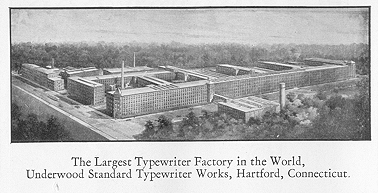 But, with great ingenuity,
he also managed to get the machine down to the same size as the Corona
but without the need for a folding carriage. The 1919 Underwood Standard Portable is a masterpiece of
engineering in miniature and is still today one of the easiest machines to type
on ever produced. Perhaps the only design weakness is the double carriage-shift
mechanism which requires a fair bit of finger exertion on the part of the
typist! Together with its case, the 3-bank model weighs 9-3/4 Lbs and the
case dimensions are 12-1/4 inches by 10 inches by 5-1/2 inches high. The overall
size is closely similar to the Corona 3 but the all-steel construction of the
Underwood means it is some 50% heavier, although still a very light and easy to
carry machine. Underwood advertising in the 1920s placed great
emphasis on the convenience and efficiency provided by this lightness and
portability, its ads of the period showing the busy man of affairs boarding a
plane carrying his Underwood Portable, no doubt to catch up with his
correspondence while flying. In the early 1920s, But, with great ingenuity,
he also managed to get the machine down to the same size as the Corona
but without the need for a folding carriage. The 1919 Underwood Standard Portable is a masterpiece of
engineering in miniature and is still today one of the easiest machines to type
on ever produced. Perhaps the only design weakness is the double carriage-shift
mechanism which requires a fair bit of finger exertion on the part of the
typist! Together with its case, the 3-bank model weighs 9-3/4 Lbs and the
case dimensions are 12-1/4 inches by 10 inches by 5-1/2 inches high. The overall
size is closely similar to the Corona 3 but the all-steel construction of the
Underwood means it is some 50% heavier, although still a very light and easy to
carry machine. Underwood advertising in the 1920s placed great
emphasis on the convenience and efficiency provided by this lightness and
portability, its ads of the period showing the busy man of affairs boarding a
plane carrying his Underwood Portable, no doubt to catch up with his
correspondence while flying. In the early 1920s, 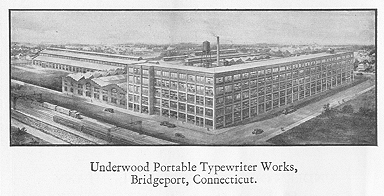 Underwood began to
make inroads into Corona's portable market, just as it had into Remington's desk
machine market two decades earlier. But
while brilliantly designed from an engineering standpoint there was a marketing
problem built into the Underwood Portable. People who bought Coronas were,
in the main, individuals who had never owned a typewriter before, to whom a
three-bank keyboard was accepted. But Underwood was selling to its own
customers -- who were used to a four-bank keyboard. Using the three-bank
Portable with its relatively clumsy shift arrangement meant changing their old
habits and learning new ones. When, at the end of 1920, Remington unveiled
its portable machine, with a full sized four-bank keyboard and only a single,
very light shift, Underwood was forced to respond and its designers produced a
4-bank version launched in 1926. The 3-bank machine continued in production
until 1929, and its 4-bank successor became one of the most successful portable
typewriters, selling more than 1,250,000 machines between 1926 and 1947 when
production ceased, putting it
alongside the Corona 3 as one of the all-time best-sellers. The
4-bank machine was just a trifle bigger than its predecessor with case
dimensions of 12 inches by 12-1/8 inches by 5-1/2 inches high, but the weight
was up significantly to 13-1/2 Lbs (including case) making it twice as heavy as
the Corona 3. However, this no longer mattered because the main competition now
was the Remington Portable. The design details of the 4-Bank machine
changed slightly over its lifetime, so there are recognisably ‘early’ and
‘later’ versions. These are the main points of difference. The ‘early’
4-bank has a number of points of similarity with its 3-Bank predecessor. The
ribbon spools are open, not covered, and held on by keeper screws. Later
machines have spool covers with the Underwood logo cut out. The case and
baseboard of early machines is identical to the case of the 3-Bank machine;
later the case changes. The shift lock is not a glass-topped key but a nickel
plated lever. Early machines have a ribbon reversal lever at the top right
of the front plate (exactly like that of the Royal Portable), but on later
machines, the ribbon reversal mechanism becomes a cylindrical knurled knob at
the bottom of the right hand side, similar to the Remington Portable. Most
obvious of all; early machines have "Underwood Standard Four Bank
Keyboard" in gilt on the paper table. Later machines just say
"Underwood". Early machines also have a list of patents on the back
plate, like the 3-bank machine, while later machine simply carry the Underwood
logo. Around 1939, Underwood produced a simplified, lower-cost model with
no frills. This machine has open ribbon spools (and thus looks a
little like the original 1926 machine) has only a single colour ribbon
and no paper bail or clips. Oddly, the case went back to a plain
early 1920s style leather strap which was presumably cheaper than a
leather-covered metal handle. During the 1930s and 1940s, Underwood
forgot its enmity with its old rival Remington and there were several
cooperative ventures. The most successful was Remington's
introduction of the Noiseless Portable and a collaboration under which
Remington manufactured the same machine carrying the Underwood name. (In
fact, the machine used as the Home icon on this site is a Remington-made
Noiseless with the Underwood logo). In 1960
Underwood introduced its Model 18 portable and this sold more than half a
million units in only three years, showing how widespread the use of portable
typewriters had become. Despite this sales success, Underwood was taken over by
Olivetti in the 1960s and its brand all but disappeared. Underwood began to
make inroads into Corona's portable market, just as it had into Remington's desk
machine market two decades earlier. But
while brilliantly designed from an engineering standpoint there was a marketing
problem built into the Underwood Portable. People who bought Coronas were,
in the main, individuals who had never owned a typewriter before, to whom a
three-bank keyboard was accepted. But Underwood was selling to its own
customers -- who were used to a four-bank keyboard. Using the three-bank
Portable with its relatively clumsy shift arrangement meant changing their old
habits and learning new ones. When, at the end of 1920, Remington unveiled
its portable machine, with a full sized four-bank keyboard and only a single,
very light shift, Underwood was forced to respond and its designers produced a
4-bank version launched in 1926. The 3-bank machine continued in production
until 1929, and its 4-bank successor became one of the most successful portable
typewriters, selling more than 1,250,000 machines between 1926 and 1947 when
production ceased, putting it
alongside the Corona 3 as one of the all-time best-sellers. The
4-bank machine was just a trifle bigger than its predecessor with case
dimensions of 12 inches by 12-1/8 inches by 5-1/2 inches high, but the weight
was up significantly to 13-1/2 Lbs (including case) making it twice as heavy as
the Corona 3. However, this no longer mattered because the main competition now
was the Remington Portable. The design details of the 4-Bank machine
changed slightly over its lifetime, so there are recognisably ‘early’ and
‘later’ versions. These are the main points of difference. The ‘early’
4-bank has a number of points of similarity with its 3-Bank predecessor. The
ribbon spools are open, not covered, and held on by keeper screws. Later
machines have spool covers with the Underwood logo cut out. The case and
baseboard of early machines is identical to the case of the 3-Bank machine;
later the case changes. The shift lock is not a glass-topped key but a nickel
plated lever. Early machines have a ribbon reversal lever at the top right
of the front plate (exactly like that of the Royal Portable), but on later
machines, the ribbon reversal mechanism becomes a cylindrical knurled knob at
the bottom of the right hand side, similar to the Remington Portable. Most
obvious of all; early machines have "Underwood Standard Four Bank
Keyboard" in gilt on the paper table. Later machines just say
"Underwood". Early machines also have a list of patents on the back
plate, like the 3-bank machine, while later machine simply carry the Underwood
logo. Around 1939, Underwood produced a simplified, lower-cost model with
no frills. This machine has open ribbon spools (and thus looks a
little like the original 1926 machine) has only a single colour ribbon
and no paper bail or clips. Oddly, the case went back to a plain
early 1920s style leather strap which was presumably cheaper than a
leather-covered metal handle. During the 1930s and 1940s, Underwood
forgot its enmity with its old rival Remington and there were several
cooperative ventures. The most successful was Remington's
introduction of the Noiseless Portable and a collaboration under which
Remington manufactured the same machine carrying the Underwood name. (In
fact, the machine used as the Home icon on this site is a Remington-made
Noiseless with the Underwood logo). In 1960
Underwood introduced its Model 18 portable and this sold more than half a
million units in only three years, showing how widespread the use of portable
typewriters had become. Despite this sales success, Underwood was taken over by
Olivetti in the 1960s and its brand all but disappeared.
The Portable Typewriter Website
Copyright © Richard Milton 2003-2004
|
